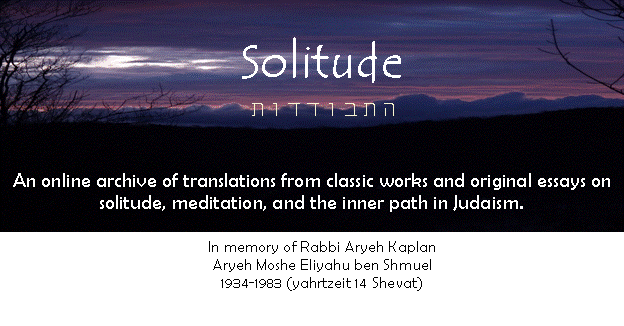From A Simple Jew - July 2007
Question: The sources you quoted sound intriguing. But how can you actually learn to practice this kind of meditation? There don’t seem to be any shiurim offered in this kind of thing at the local Orthodox synagogue.
Answer: A Chassidic scholar in Jerusalem who prefers to remain anonymous has devoted most of his life to searching for the elusive "inner point" of the Baal Shem Tov’s teachings, as well as the roots of "Toras HaBaal Shem Tov" in earlier Jewish mystical writings. His ongoing series of source-books on this subject is entitled "Shiva Einayim (Seven Springs)," and now numbers five volumes. Sometimes these books are available in the U.S. through Moznaim Publishing, 4304 Twelfth Ave., Brooklyn, NY (718-853-0525).
He also teaches people, I have been told. But if you don’t live in Yerushalayim, that won’t help too much.
In Brooklyn, I don’t know who is adept in this aspect of Chassidus, which has widely fallen into disuse. Maybe Rabbi Mordechai Zilber, the Stutchiner Rebbe on 54th St. or Rabbi Yosef Borukh Pinchos Rabinowitz, the Skolye Rebbe of 48th St., have some mesorahs about it. Both are both scholars and masters of Chassidus (although representing different traditions), whose knowledge is from the "inside" and not just the "outside." However, be forewarned: people tend to be very secretive about this kind of thing in the Chassidic world today.
I never heard of any special techniques related to how one should sit or breathe, etc., as in some forms of meditation developed by Far Eastern schools, which in any case are bound up with other religions. (Like most Chassidim, I am not in the right physical shape to spend much time in the lotus position!) In Breslov, the form of hisbodedus we practice doesn’t involve any special physical preparations or techniques, aside from finding a nice secluded place that is free from distractions, and standing or sitting there until the words start to come. Sometimes the silent part of hisbodedus just happens spontaneously. However, if one wants to focus on silent meditation, I would say that a chair and the inner resolve are all you need.
Question: Where can you read more about the Baal Shem Tov’s formal teachings?
Answer: For those who have never studied the Baal Shem Tov’s teachings before, three good anthologies are: Keser Shem Tov (gleaned from the works of Rabbi Yaakov Yosef of Polonoye); Sefer Baal Shem Tov Al Ha-Torah (Two Volumes); and a more recent collection, Me’ir Eynei Yisrael. These books, too, should be available from Moznaim in Brooklyn.
I translated some of this material in The Path of the Baal Shem Tov about ten years ago; and Rabbi Immanuel Schochet of Chabad translated Tzava’at HaRivash, one of the first collections of sayings and short lessons from the Baal Shem Tov and the Maggid of Mezeritch, with scholarly annotations.
Rabbi Aryeh Kaplan devoted an entire section to the Baal Shem Tov and early Chassidic teachings in his ground-breaking study, Meditation and the Kabbalah, as well as in Chassidic Masters.
Another address is Rabbi Menachem Nochum of Chernobyl’s Ma’or Einayim. Although the Chernobyler Maggid, as he is also known, became a Chassidic master in his own right, he was one of the younger talmidim of the Baal Shem Tov and later the Maggid, and his explanations of the original teachings of Chassidism are widely considered to be among the most cogent. Samples of these works are available online at http://www.baalshemtov.com/
